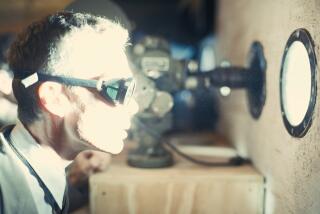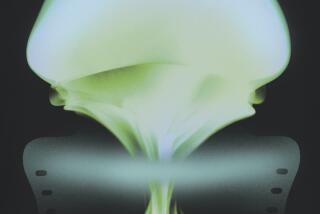John Gofman, 88; physicist warned about radiation risks
Dr. John W. Gofman, the medical physicist whose fight for what he considered scientific honesty in understanding the health effects of ionizing radiation made him a pariah to the nuclear power industry and the U.S. government, died of heart failure Aug. 15 at his home in San Francisco. He was 88.
Often called the father of the antinuclear movement, Gofman and his colleague at Lawrence Livermore National Laboratory, Arthur R. Tamplin, developed data in 1969 showing that the risk from low doses of radiation was 20 times higher than stated by the government.
Their publication of the data, despite strong efforts to censor it, led them to lose virtually all of their research funding and, eventually, their positions at the government laboratory.
Most of their conclusions have subsequently been validated, but critics say the risks have been ignored by an electric power industry that sees nuclear energy as a pollution-free alternative to fossil fuels and by a medical industry that continues to use much larger amounts of radiation for medical tests than are required.
“He always stood up for the integrity of science,” said Charles Weiner, professor emeritus of the history of science at MIT.
“He was really an original voice” in the debate over the risks of nuclear power, Weiner said, “someone who was an insider in nuclear weapons production who was very highly regarded by leaders in the field . . . and who brought credential, credibility and authority.”
Until his death, Gofman’s position continued to be that there is no safe level of exposure to ionizing radiation.
“Licensing a nuclear power plant is, in my view, licensing random premeditated murder,” Gofman said in the 1982 book “Nuclear Witnesses: Insiders Speak Out.”
“First of all, when you license a plant, you know what you are doing -- so it’s premeditated. You can’t say, ‘I didn’t know.’ Second, the evidence on radiation producing cancer is beyond doubt. . . . It’s not a question anymore: Radiation produces cancer, and the evidence is good all the way down to the lowest doses.”
Gofman and Tamplin’s data about the health effects of radiation -- and their revelations about the Atomic Energy Commission’s attempts to silence them -- played a large role in the demise of that organization in 1974.
The Atomic Energy Commission was divided into two organizations: the Energy Research and Development Administration, whose goal was to promote the development of atomic energy, and the Nuclear Regulatory Commission, which was supposed to monitor the safety of the nuclear industry.
Gofman argued, however, that the changes were merely cosmetic and that the Nuclear Regulatory Commission continued to promote nuclear power to the detriment of the public at large.
In 1971, he helped found the Committee for Nuclear Responsibility, a San Francisco-based advocacy group that studies the health effects of ionizing radiation. During that decade, he and others unsuccessfully argued for a five-year moratorium on the construction of new nuclear power plants, arguing that the generation of massive quantities of radioactive waste made them a major health risk.
The 1979 accident at Three Mile Island in Pennsylvania and the 1986 Chernobyl meltdown in the Soviet Union proved to be much more powerful arguments against the industry, however, and construction of new facilities slowed dramatically in their wakes.
Although nuclear power today accounts for 20% of the electric power generated in the United States, the last new nuclear power plant to be completed was the Watts Bar 1 plant in Tennessee, which came online in 1996.
More recently, Gofman had argued forcefully that radiation is overused in medicine, both for diagnosis and treatment, without a full consideration of the risks. He noted that some hospitals use as much as 100 times the required radiation for imaging. He also argued that CT scans are used too often when less dangerous approaches are available.
Many of Gofman’s colleagues viewed his ultimate opposition to nuclear power as a long, strange journey for a scientist who had been intimately associated with the creation of the industry.
John William Gofman was born Sept. 21, 1918, in Cleveland, the son of Russian immigrants. After finishing high school during the Great Depression, he attended nearby Oberlin talking his way in and wangling a scholarship despite the fact that admissions were formally closed.
After graduating, he enrolled in medical school at Cleveland’s Western Reserve University. After a year, however, he took a leave of absence and enrolled in the chemistry program at UC Berkeley.
Upon his arrival there, Dean Gilbert Newton Lewis told Gofman that he wanted him to begin his research project “in the next week or two.” After talking to several professors, he met with future Nobel laureate Glenn Seaborg, who suggested that he might examine whether uranium-233 could exist in nature.
Intrigued, Gofman signed on, and he and his colleagues produced four one-millionths of a gram of the isotope in the Berkeley cyclotron and proved that it would fission spontaneously.
He also was the co-discoverer of protactinium-232, uranium-232 and protactinium-233 during his graduate student years.
As a postdoctoral fellow at Berkeley, he was working on ways to isolate plutonium from uranium that had been bombarded with neutrons. Although the Manhattan Project was then building a massive plant in the Pacific Northwest to produce plutonium, at that time there was less than a quarter of a milligram of it in existence.
“There was so little plutonium that our research team had never even seen the element,” he said later.
But in 1942, physicist J. Robert Oppenheimer, who headed the Manhattan Project, went to Gofman and told him that half a milligram of plutonium was needed immediately for crucial experiments that would determine the direction of the project.
Gofman and his colleagues packed a ton of uranyl nitrate around the Berkeley cyclotron and irradiated it with neutrons day and night for six weeks. Then, working with 10-pound batches of the uranium, the team spent three weeks working around the clock to isolate half a cubic centimeter of liquid containing 1.2 milligrams of plutonium -- twice as much as they had expected.
Despite his later antinuclear stance, Gofman said, he had no guilt about his role in the development of the atomic bomb, citing the “human monstrosity” of Germany’s Nazi regime.
After his work on plutonium was completed, Gofman returned to medical school at UC San Francisco. He earned his medical degree in 1946.
He had some thoughts about the then-unknown links between hardening of the arteries and cholesterol in the bloodstream and decided to study lipoproteins, which are large molecules consisting of proteins tied to fats.
“I didn’t want to work on anything less than a big medical problem,” he said.
In his studies he used an ultracentrifuge, a device that spun a solution at high speeds to produce layers of components of different molecular weights. But, like other researchers, he found that the lipoproteins could not be resolved into distinct layers -- a finding that led many researchers to speculate that they were breaking down during the process.
Gofman found that adding salt to the solution would cause the lipoproteins to float and separate from the other proteins. “As a result of this discovery, we were able to open up a manner of looking at molecules no one even knew had existed [and] discover a whole series of new lipoproteins,” he said.
He demonstrated the existence of high-density and low-density lipoproteins and showed their roles in the development of atherosclerosis.
His work was branded “the Gofman heresy.” But, in May, the Journal of Clinical Lipidology reprinted his key paper and called it a “historically important presentation of concepts that underpin our field.”
The approach has been widely used throughout heart disease research and won him a share of the 1972 Stouffer Prize, which was then the highest American award in heart disease research.
After earning his medical degree, Gofman took teaching positions at both Berkeley and UC San Francisco.
By 1957, he decided he had had enough of heart disease research. “I’m not very good at dotting I’s and crossing Ts,” he said. “If it’s not something really new and unknown, it’s not something I want to do.”
Gofman shifted his research to study trace elements in human biochemistry. But in 1962, he got a call from John Foster, director of Lawrence Livermore National Laboratory, inviting him to set up a radiation biology laboratory there.
With a budget of $3 million a year, he began studying potential hazards of radiation, but immediately began butting heads with Washington bureaucrats.
He objected vehemently to a new program called Project Plowshare, which would use nuclear weapons for peaceful purposes. The Atomic Energy Commission proposed building a new sea-level Panama Canal through Nicaragua, for example, by using 315 megatons of hydrogen bombs to blast out the soil.
The project eventually was halted by the nuclear test ban treaty, which forbade above-ground nuclear explosions.
Gofman had aroused a great deal of enmity in Washington, and by the early 1970s he had lost virtually all of his research grants. He retired formally in 1973 and spent the rest of his career writing books about the risks of medical radiation and continuing his research on nuclear hazards.
Gofman’s wife, Dr. Helen Fahl Gofman, a pediatrician, died in 2004. He is survived by a son, Dr. John D. Gofman, an ophthalmologist, of Bellevue, Wash.






